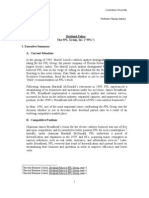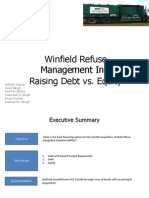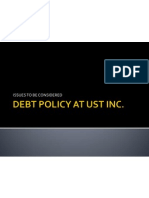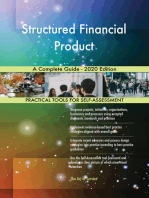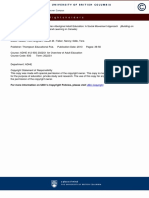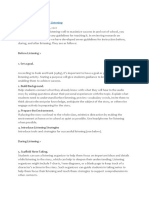Dividend Policy at PFL Group
Dividend Policy at PFL Group
Uploaded by
Wthn2kCopyright:
Available Formats
Dividend Policy at PFL Group
Dividend Policy at PFL Group
Uploaded by
Wthn2kCopyright
Available Formats
Share this document
Did you find this document useful?
Is this content inappropriate?
Copyright:
Available Formats
Dividend Policy at PFL Group
Dividend Policy at PFL Group
Uploaded by
Wthn2kCopyright:
Available Formats
Dividend Policy at PFL Group, Inc. FPL An Overview FPL Group, Inc. is Floridas largest electric utility company.
. In 1925, through the consolidation of numerous electric and gas companies, they formed Florida Power & Light Company (FP&L). FP&L grew steadily over the next 50 years until rising fuel costs, operating issues, and construction costs began to decrease profitability. In the mid-1980s, FPL diversified with four major acquisitions - Colonial Penn Life Insurance Company, Telesat Cablevision, Inc., CBR Information Group Inc., and Turner Foods Corporation- in order to minimize the potential risk within the utilities industry. To address problems in operations, FPL began a rigorous program of Japanese-inspired quality control. Management succeeded in transforming FPL into a lean operational system resulting in a drop in scheduled downtime from 18% to 4%, while customer complaints also fell by 60%. By 1989, FPL was recognized as one of the best-managed U.S. corporations. Despite the progress in quality, FPL was still dealing with problems: Colonial Penn was losing money, there were safety concerns about a particular nuclear plant, and demand was growing faster than capacity. In 1989, James Broadhead succeeded Chairman Marshall McDonald. Broadhead placed an emphasis on commitment to quality and customer service, increasing focus on the utilities industry, expanding capacity, and improving cost positions. He took measures to scale back the intense quality controls while still working to preserve the high level of operational efficiency. Furthermore, Broadhead brought focus back to FPLs core business utilities, by selling off many of its non-utility businesses. FPL also budgeted $6.6 billion, spread over five years, for expansion. They funded the development through internal profits and by issuing $3.7 billion of long-term debt and $1.9 billion of common stock. The Electric Utility Industry FPL is an established leader in the utility industry. They have proven their ability to survive and succeed in the dynamic and evolving competitive market. The electric utility industry has established itself as a vital public service within todays society. Until the 1970s and 1980s, the government played a major role in determining the rates, returns, and capacity planning of the power industry. Congress passed several laws regulating the sale of wholesale energy and even formed committees to monitor utility companies dealings. Deregulation In the 1970s and 1980s deregulation weakened the monopolies that had dominated the trucking, banking, airlines, natural gas, telecommunication, and eventually the electric utilities industry. By 1978 most major segments were faced with mandatory changes. In 1992 the National Energy Policy Act (NEPA) was passed requiring utility companies to make their transmission systems available to third-party users at the same level of cost. A clatter of legal quarrels ensued thereafter and FPL was accused of charging excessive rates and denying fair access to its system. In 1994, the industry was facing deregulation of the last segment - distribution. While states such as California and Michigan had toyed with the retail wheeling concept in the past as a way to increase competition, Florida had not yet adopted this method. Retail wheeling allows customers to buy power from any utility, not just their local monopoly supplier. Data from the California experimentation with retail wheeling indicated an average loss of 8% of market value per utility company once this method was initiated Recent Happenings in the Electric Utility Industry Despite Californias proposal on retail wheeling, as of May 1994, the Florida Public Service Commission was not considering implementing the policy. Although FPL is the largest electric utility in the state, retail wheeling would greatly increase the amount of competitors in the market. The industry faces a challenging future full of change, and shareholders would benefit from understanding the potential risks and rewards of their investment. The Standard & Poors Ratings Group declared a revision to their guidelines for evaluating utilities in October of 1993. This revision included the utilities competitive position as part of its financial rating. FPLs
positions rose based on the new criteria, placing them in the top 10% of publicly owned utilities. Major Issues Confronting FPL in 1994 In spite of a favorable position rating, FPL cannot ignore the deregulation movements threatening their current business landscape. The most important issues facing FPL in May 1994 are potential competition resulting from industry deregulation and their high payout ratio. 1) Retail Wheeling The threat of retail wheeling within FPLs market forces management to consider whether or not they can maintain high payout ratios. Retail wheeling is reshaping the utilities industry and if enacted in Florida, it will bring grave challenges to the future of FPL. 2) Low Capacity Margin FPL must prepare for increased competition from the establishment of retail wheeling and other forms of distribution deregulation. FPL is an old firm which is running at roughly 92% capacity. Their low capacity margin (8.6%) suggests that they have less room for growth compared to their competitors. FPL must work to foster growth in order to survive in an evolving industry. 3) Transmission & Power Costs FPL carries a transmission cost of nearly double the industry average. FPLs cost is $.0019 compared to the $.0010 of their peers. With the potential onslaught of competitors, these high costs will hinder FPLs ability to compete. Furthermore, FPLs power generation costs are high because they purchase 30% of their power used in the generation process from outside sources. Thus, they are subject to any price sensitivity in the power market. 4) High Payout Ratio The payout ratio interprets the amount of earnings paid out in dividends from earnings available to shareholders. Currently, FPL has a payout ratio of 90%. While it is true that firms in the utilities industry typically have a high payout ratio, FPLs ratio is abnormally high. Given the possibility of expansion due to increased competition, FPL cannot afford to carry on such a high payout ratio. By decreasing the payout ratio, FPL can use a higher portion of earnings to encourage growth and safeguard against competition. Dividend Policy Firms pay dividends for several reasons; however the main reason is to reward shareholders for investing in the firm. Dividends send a signal to current and future investors that the company is financially stable. It also tells investors that they are sharing in the firms profits, and encourages them to continue with their investment. There have been several debates regarding the benefits of consistent dividends for the investor. No one theory is conclusive concerning whether or not dividends should be paid, however they all agree that the companys dividend policy should be based upon the shareholders preference. Dividend Policy Theories When discussing whether or not to pay dividends, theorists have come up with three alternatives: MM Indifference, Bird in hand (or dividend preference) and Tax preference (or dividend dislike). 1.) Dividend Indifference The leading proponents of this theory are Merton Miller and Franco Modigliani (MM). MM argue that a stocks price is only determined by its earnings and business risk. MMs claim that dividend policy is irrelevant is based on the idea that any shareholder can create their own dividend policy. If a stock does not pay dividends, and a shareholder wants a dividend, they can simply sell enough of their stock to create the desired dividend. Conversely, if a stock pays a dividend, and the shareholder does not want the dividend, then they simply use the payout to buy additional shares. Imagine two stocks, X and Y. Suppose these two stocks have the same earnings and business risk, but stock X pays more of its earnings out as dividends and has a higher price. According to MM, investors will sell X and buy Y if they dont want this high dividend payout. Due to their low payout ratio, Ys share price should rise faster than Xs because it is plowing back more of its earnings. Ys investors who want more dividends could sell enough of their shares to make up for the dividend shortfall. They then argue that arbitrage would occur until X and Y sold at the
same price. Although this theory has not been proved wrong, MM make a number of assumptions. Two of the major assumptions are the absence of taxes and brokerage costs which in reality may have a large effect on the net profit an investor receives. Based on this theory, FPL investors should have no preference whether they continue to allow their dividend to grow, or withhold it and allow for more capital gains. 2.) Bird-in-Hand The main conclusion from the MM irrelevance theory is that a companys dividend policy has no affect on the required rate of return on equity, rs. This idea has been debated by several individuals; however the main objectors have been Myron Gordon and John Lintner. Based on old proverb that says a bird in the hand is worth two in the bush, Gordon and Lintner argue that a dividend payout causes rs to decrease because investors believe that capital gains which are kept invested in the company are more risky and subject to loss than the dividends they have already earned and have in their hand. Gordon and Lintner are saying that investors value a dollar of expected dividends more than a dollar of expected capital gains. They theorize that this is the case because the dividend yield component, D1/P0 is less risky than the g component in the expected return equation, rs = D1/P0 + g MM disagree with this position. MM argue that rs is independent of dividend policy, implying that investors are indifferent between D1/P0 and g. If this is the case then investors are indifferent between dividends and capital gains. In MMs view, investors tend to reinvest their dividends in stock from the same company, or stock of similar companies. When investors do this, they are exposing themselves to the same risk as they would have if the company had kept the dividend, invested the proceeds, and not given a payout. If an investor believes the bird-in-hand theory to be right, they will want FPL to either keep their current dividend consistent or continue increasing it as they have for the past 47 years. 3.) Tax Preference The tax preference theory gives three reasons why investors may want low dividend payouts due to their tax effects. The first reason is that long-term capital gains have a maximum tax rate of 20%. This differs from dividends which are taxed at incremental effective rates. With this in mind, wealthy investors would prefer companies which retained earnings back into the business and not receive dividends. The second tax effect deals with the time value of money. The value of a dollar paid in taxes in the future has a lower effective cost than a dollar paid today. Finally, beneficiaries, one who receives the stock upon death, pay no taxes on the capital gains at all. Therefore, they escape the tax altogether. FPL investors may want to defer the payment of taxes or attempt to avoid taxes all together on their gains and have FPL cut their dividend. Dividend Policy: Cut or Hold Constant Two additional theories that deal with a company changing their dividend policy are the Clientele Effect and the Signaling Effect. 1.) Clientele Effect There are many groups of investors within the market that prefer different payout ratios. Investors often look for a company in which maintains a payout ratio similar to their preferences. If a company decides to change their dividend policy or their payout ratio due to strategy decisions their shareholders or clientele might decide to sell their shares in that company and invest in another. If enough new shareholders are not in line to replace these old shareholders, the stock price may drop. On the other hand, if there is a newfound demand for this dividend payout more shareholders may want this stock than previously and the stock price may increase. Retired individuals, pension funds, and university endowments prefer high dividends and as a result have been attracted to the energy market and specifically this stock in the past due to its dividend policy. Therefore, their clientele is believed to be those who prefer a high and consistent
dividend. If FPL does end up reducing their payout ratio, individual shareholders will be more likely to sell their shares and move to another company with a high dividend payout. If this is the case, FPLs stock price may fall in price. 2.) Signaling Effect Due to asymmetric information between managers and shareholders, shareholders often look at management decision for indications about the future performance of the company. Therefore, if FPL management decides to decrease the dividend, the market often views this as a negative sign regarding future profits and their stock price will decline. On the other hand, if management increases the dividend this sends a positive signal to the market which will lead to an increase in the price of the stock. For example, if FPL cut their dividend payout ratio by 30%, there would be a larger percentage of earnings dedicated towards growth. Cutting the payout ratio would provide FPL as much as $150 million additional cash per year. This newfound cash can be used to pay off debt or finance growth. Another potential impact of decreasing the payout ratio is FPL would have the ability to repurchase outstanding shares. As the number of shares outstanding decreases, the earnings per share will increase, assuming all else remains unchanged. This speculation can potentially offset the negative signal sent to the market as a result of cutting the dividend amount. Furthermore, when a company repurchases their stock it signals management feels their stock is undervalued. Overall Analysis FPL faces many challenges. The recent drop in stock price, along with the favorable estimation of future earnings would inevitably suggest a buy recommendation. After researching the electrical utilities industry, it is apparent that FPL is on the brink of a major change in their industry. It becomes increasingly difficult to predict how Florida will implement deregulation within the industry. The thought of retail wheeling is not assuring; however, we feel that FPL is a strong company choosing to make a preemptive move to prepare for the future changes in their industry. We anticipate deregulation in distribution to be fully implemented by the Florida government and FPL will be ready to handle the competition. As we have discussed, companies usually decrease their dividend payout ratio for negative reasons; however we feel that FPL should decrease their ratio due to strategic growth. An analysis of dividend payout ratios within the electric utilities industry reveals the range to be from 60% to 106% (See Exhibit 9). By comparing the range of ratios with potential future growth, we have found that the most strategic position for FPL to be is at the lower end of the industry. If FPL cut their payout ratio by 30%, it will give them the opportunity to retain more in equity and increase their payout at a faster rate in the years to come. One obvious concern FPL has with such a dramatic reduction in dividends is their shareholders reaction. The clientele effect suggests that if the current shareholders choose to sell because of the new dividend payout ratio, a new set of investors who are seeking a low dividend, high growth stock will step in to buy the shares. Recommendation Our recommendation depends on the personal needs of the investor. If the investor has the stock because of the high payout ratio, then we recommend selling. These individuals expect high, steady dividends that they have seen in the past; however, this will not be the case anymore. They need to sell as soon as possible because the news of this new dividend structure will most likely drive the price of the stock down and result in a capital loss. If the shareholder is investing for reasons other than the historically large cash dividend, they should hold the stock because we feel that there is a high likelihood of growth in the future. Based on extensive analysis, we believe that the FPL Group will continue to show growth and profitability. 1993 was a record year for the company, in terms of their net income and price per share. According to company statements, 1994 will be an even better year, with increasing sales and decreasing capital expenditures. FPL has repeatedly shown above average sales growth. Given their preemptive strike on the potential competition from deregulation we believe in their continued success. With this in mind, they would not want to sell their shares and potentially lose
the capital gain that is coming to them. Our final recommendation is to those investors who do not currently own shares in FPL. For these individuals we would recommend waiting until after the news of this new dividend structure, then buy. Based on the signaling theory, if FPL repurchases shares, the negative affect of the lower dividend may be somewhat offset; however we believe that the news of the new dividend structure will inevitably drive the price of the stock further down. The best time for these investors to buy is when the stock price is at its absolute lowest. If they wait until then, they will have the highest possible capital gain. Conclusion Dividend policy is a very sensitive subject that involves many theories. Whenever changes are made in a companys dividend policy they need to be aware of what signal it sends, and how the market will react. There is no one right answer when determining optimal dividend structure. Individual companys need to look at their own financial statements, position in the industry, and corporate goals to decide which structure will be best for them.
You might also like
- 83592481 (1)Document3 pages83592481 (1)MedhaNo ratings yet
- Moody's Analytics Interview QuestionsDocument2 pagesMoody's Analytics Interview QuestionsAyush KapoorNo ratings yet
- Pricing and Valuation of Forward Commitments: LiteratureDocument6 pagesPricing and Valuation of Forward Commitments: LiteratureAlvianNo ratings yet
- XdocmulationDocument4 pagesXdocmulationKuthe Prashant GajananNo ratings yet
- Winfield ManagementDocument5 pagesWinfield Managementmadhav1111No ratings yet
- Chapter 15 M&A, Takeovers, Corporate Control5Document22 pagesChapter 15 M&A, Takeovers, Corporate Control5toshiba1234No ratings yet
- FPL Dividend Policy-1Document6 pagesFPL Dividend Policy-1DavidOuahba100% (1)
- FPLDocument20 pagesFPLJasmani CervantesNo ratings yet
- Dividend Policy Analysis Florida Power LightDocument5 pagesDividend Policy Analysis Florida Power LightShilpi Kumari100% (1)
- FPL SolutionsDocument4 pagesFPL SolutionsMegan Lo75% (4)
- Carrefour S.ADocument1 pageCarrefour S.ATeja_Siva_89090% (1)
- Q3 Quizz 3 Michigan FinanceDocument46 pagesQ3 Quizz 3 Michigan FinanceRalNo ratings yet
- Cost of Capital QDocument2 pagesCost of Capital QPrinkeshNo ratings yet
- Carrefour Group 8Document9 pagesCarrefour Group 8IzzaNo ratings yet
- International Corporate FinanceDocument1 pageInternational Corporate FinanceAnkushNo ratings yet
- Stock-Trak Project Final Preparation GuidlinesDocument1 pageStock-Trak Project Final Preparation GuidlinesKim Yoo SukNo ratings yet
- Facebook IPO Valuation AnalysisDocument13 pagesFacebook IPO Valuation Analysislucy0557100% (2)
- How To Valuation A CompanyDocument42 pagesHow To Valuation A Companyapi-3720563100% (3)
- BP Amoco (A)Document8 pagesBP Amoco (A)BhartiMahawarNo ratings yet
- Check Out My 'Advanced Culture-Fair IQ Test' Results From The IQ Comparison SiteDocument4 pagesCheck Out My 'Advanced Culture-Fair IQ Test' Results From The IQ Comparison SiteMia SercoNo ratings yet
- Solutions HatcherDocument33 pagesSolutions HatcherAnonymous AtcM8k5J100% (1)
- AmoghDocument16 pagesAmoghrohanNo ratings yet
- Dividend Policy at FPL GroupDocument20 pagesDividend Policy at FPL Groupczx88No ratings yet
- Case 5 - FPL Group Questions)Document1 pageCase 5 - FPL Group Questions)Jasper Yip0% (1)
- Chapter 6 Bond - Assignment AnswerDocument6 pagesChapter 6 Bond - Assignment AnswerRoger RogerNo ratings yet
- Winfield PPT 27 FEB 13Document13 pagesWinfield PPT 27 FEB 13prem_kumar83g100% (4)
- A 109 SMDocument39 pagesA 109 SMRam Krishna KrishNo ratings yet
- Porsche Volkswagen Case StudyDocument3 pagesPorsche Volkswagen Case Studydivakar62No ratings yet
- FPL Group TemplateDocument3 pagesFPL Group Templatesathyanl90No ratings yet
- Dividend Policy at FPL Group: Submitted byDocument13 pagesDividend Policy at FPL Group: Submitted byismathNo ratings yet
- Econ 121 Money and Banking: Problem Set 2 Instructor: Chao WeiDocument2 pagesEcon 121 Money and Banking: Problem Set 2 Instructor: Chao WeideogratiasNo ratings yet
- B392Document7 pagesB392LOVE EMPIRE0% (1)
- Purchasing Power Parity & The Big Mac IndexDocument9 pagesPurchasing Power Parity & The Big Mac Indexpriyankshah_bkNo ratings yet
- GE Class E Contingent NoteDocument7 pagesGE Class E Contingent NoteSureshNo ratings yet
- TN38 Carrefour S ADocument6 pagesTN38 Carrefour S AFeeling_so_fly100% (2)
- Hong Kong DisneylandDocument10 pagesHong Kong DisneylandAnkur SinhaNo ratings yet
- IpoDocument4 pagesIpohasratbaloch22No ratings yet
- Mergers & AcquisitionsDocument2 pagesMergers & AcquisitionsRashleen AroraNo ratings yet
- Delta Beverages Case Group 3Document7 pagesDelta Beverages Case Group 3Ayşegül YildizNo ratings yet
- Assignment 4 or Poject Phase 1 (Walmart by Mehdi & Salman)Document28 pagesAssignment 4 or Poject Phase 1 (Walmart by Mehdi & Salman)Syed Mehdi BukhariNo ratings yet
- 2 Real Options in Theory and PracticeDocument50 pages2 Real Options in Theory and Practicedxc12670No ratings yet
- Corporate Finance Practice ExamDocument11 pagesCorporate Finance Practice ExamPeng Jin100% (1)
- Multinational Business Finance by Shapiro Chapter 1 SolutionsDocument10 pagesMultinational Business Finance by Shapiro Chapter 1 SolutionsEdward YangNo ratings yet
- Kmart CaseDocument22 pagesKmart CaseDamiano SciutoNo ratings yet
- Solutions Chapters 10 & 11 Transactions and Economic ExposureDocument46 pagesSolutions Chapters 10 & 11 Transactions and Economic ExposureJoão Côrte-Real Rodrigues50% (2)
- Case Study - Porsche Vs VolkswagenDocument3 pagesCase Study - Porsche Vs VolkswagenTawfiq AMNo ratings yet
- Entry ModeDocument15 pagesEntry Modeporaghassan99No ratings yet
- Gainesboro Case AnalysisDocument8 pagesGainesboro Case AnalysisJhimcee Ghlenn Corvera100% (1)
- FRM CaseDocument14 pagesFRM CaseKevval BorichaNo ratings yet
- LTCMDocument6 pagesLTCMAditya MaheshwariNo ratings yet
- Debt Policy at Ust IncDocument7 pagesDebt Policy at Ust IncIrfan Mohd0% (1)
- Case Analysis: Murphy Stores, Capital ProjectDocument2 pagesCase Analysis: Murphy Stores, Capital Projectariba farrukhNo ratings yet
- Initial Public Offerings -- 2nd Edition: The mechanics and performance of IPOsFrom EverandInitial Public Offerings -- 2nd Edition: The mechanics and performance of IPOsRating: 5 out of 5 stars5/5 (1)
- CFA Level I Exam Companion: The 7city / Wiley Study Guide to Getting the Most Out of the CFA Institute CurriculumFrom EverandCFA Level I Exam Companion: The 7city / Wiley Study Guide to Getting the Most Out of the CFA Institute CurriculumNo ratings yet
- Credit Derivatives Pricing Models: Models, Pricing and ImplementationFrom EverandCredit Derivatives Pricing Models: Models, Pricing and ImplementationRating: 2 out of 5 stars2/5 (1)
- PRMIA: Practices for Credit and Counterparty Credit Risk Management: A Primer for Professional Risk Managers in Financial ServicesFrom EverandPRMIA: Practices for Credit and Counterparty Credit Risk Management: A Primer for Professional Risk Managers in Financial ServicesNo ratings yet
- Energy Trading And Risk Management A Complete Guide - 2020 EditionFrom EverandEnergy Trading And Risk Management A Complete Guide - 2020 EditionNo ratings yet
- Managing Credit Risk: The Great Challenge for Global Financial MarketsFrom EverandManaging Credit Risk: The Great Challenge for Global Financial MarketsNo ratings yet
- Structured Financial Product A Complete Guide - 2020 EditionFrom EverandStructured Financial Product A Complete Guide - 2020 EditionNo ratings yet
- Decoding DCF: A Beginner's Guide to Discounted Cash Flow AnalysisFrom EverandDecoding DCF: A Beginner's Guide to Discounted Cash Flow AnalysisNo ratings yet
- CH4: The Zone of Canadian Aboriginal Adult Education: A Social Movement ApproachDocument13 pagesCH4: The Zone of Canadian Aboriginal Adult Education: A Social Movement ApproachKawinNo ratings yet
- Leading Psychiatrist Blows Whistle On ProfessionDocument9 pagesLeading Psychiatrist Blows Whistle On ProfessionpicogyoNo ratings yet
- Back Alley Dice GamesDocument4 pagesBack Alley Dice GamesbuggerboyzNo ratings yet
- Bio Practice Set 1 2023Document6 pagesBio Practice Set 1 2023Anthony MathaiNo ratings yet
- Regner v. Logarta (CivPro - Summons)Document3 pagesRegner v. Logarta (CivPro - Summons)Cathy AlcantaraNo ratings yet
- 1 TypesDocument5 pages1 TypesOfentse Boat bouyNo ratings yet
- Brksec 3020Document188 pagesBrksec 3020Alvaro J. SarmientoNo ratings yet
- Cambaliza Vs Cristobal-TenorioDocument6 pagesCambaliza Vs Cristobal-TenorioDora the ExplorerNo ratings yet
- Internet ShoppingDocument2 pagesInternet ShoppingramzijenaihNo ratings yet
- 7 Guidelines For Teaching ListeningDocument2 pages7 Guidelines For Teaching ListeningElveEuzilaYanJulianNo ratings yet
- Opter Metro 5200Document230 pagesOpter Metro 5200pierre_ce3863No ratings yet
- Intermediate Accounting I - Investment Part 1Document3 pagesIntermediate Accounting I - Investment Part 1Joovs Joovho0% (3)
- Vocab RapDocument1 pageVocab RapMrFeatherNo ratings yet
- Negus AnalysisDocument2 pagesNegus AnalysisGarcia Toro AlbertoNo ratings yet
- Đề Minh Họa 2020 Số 35 - GV Trang Anh - Moon.vnDocument15 pagesĐề Minh Họa 2020 Số 35 - GV Trang Anh - Moon.vnLưu Lê Minh HạNo ratings yet
- Week 4 - Speech ContextDocument3 pagesWeek 4 - Speech ContextGilda Genive AriolaNo ratings yet
- Principles Unit PlanDocument10 pagesPrinciples Unit Planapi-308317958No ratings yet
- Basic Design of Counterfort SpreadsheetDocument6 pagesBasic Design of Counterfort SpreadsheetByron OcampoNo ratings yet
- A Case Study of Snowhite Dry Cleaners Pakistan PDFDocument104 pagesA Case Study of Snowhite Dry Cleaners Pakistan PDFhisroyalmajestyNo ratings yet
- The Radiant DawnDocument4 pagesThe Radiant DawnAlvin BindedNo ratings yet
- I Wandered Lonely As A CloudDocument4 pagesI Wandered Lonely As A CloudMaricrisNo ratings yet
- Diversity in Ethiopia: A Historical Overview of Political ChallengesDocument16 pagesDiversity in Ethiopia: A Historical Overview of Political Challengesaregawi selemonNo ratings yet
- Halaman Romawi Mawadah Kardina Dwi RahmawatiDocument80 pagesHalaman Romawi Mawadah Kardina Dwi RahmawatiElisa SiahaanNo ratings yet
- Pre Board 2 Maths Answer KeyDocument7 pagesPre Board 2 Maths Answer KeyV MohithNo ratings yet
- RDBMSDocument17 pagesRDBMSNadim MominNo ratings yet
- SQL Interview Questions - JavatpointDocument6 pagesSQL Interview Questions - JavatpointR VuppulaNo ratings yet
- ANSI C84.1-1995 Electric Power Systems and Equipment Voltage Ratings (60 Hertz)Document24 pagesANSI C84.1-1995 Electric Power Systems and Equipment Voltage Ratings (60 Hertz)Alejandro UshiñaNo ratings yet
- Inchange Semiconductor BU2508AF DatasheetDocument3 pagesInchange Semiconductor BU2508AF DatasheetEduardo BustosNo ratings yet








